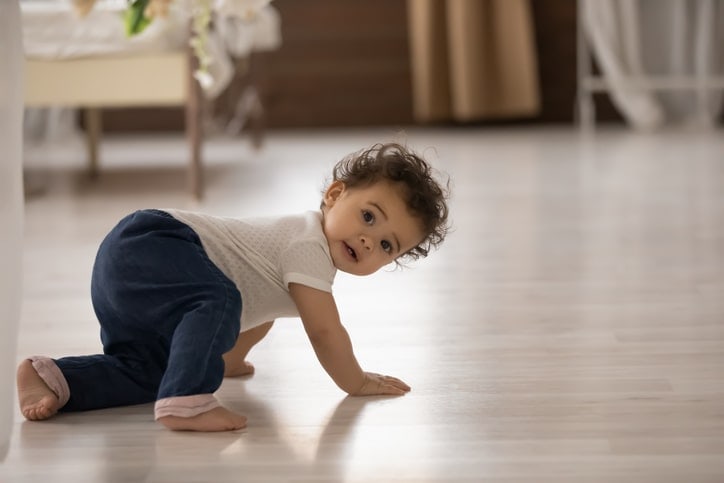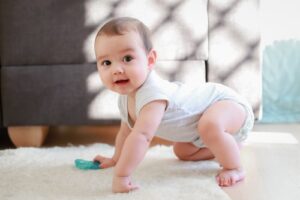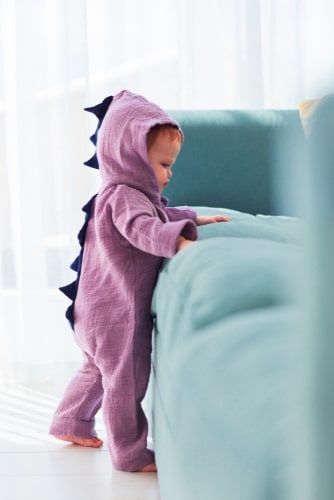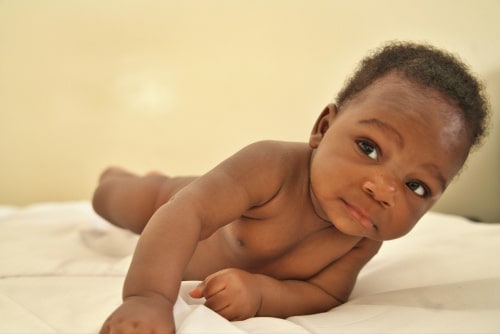
[ad_1]
When do infants crawl for the primary time? Research counsel that roughly 50% of infants start crawling by 8 months. However some infants might begin earlier than 6 months, and others might not crawl till after 11 months, if ever. In case your child doesn’t crawl, does that imply one thing is flawed? No. In some circumstances, delayed crawling generally is a signal {that a} youngster is in danger for slower motor improvement. But it surely’s additionally regular for infants to skip crawling altogether – adopting different methods of transferring from place to put.

Infants aren’t developmentally “programmed” to crawl. As an alternative, infants are motivated to experiment with other ways of transferring, and choose no matter technique appears probably the most rewarding. Thus, a child may select one in all these types of crawling:
- belly-crawling;
- hands-and-knees crawling; or
- hands-and-feet crawling;
or a child may desire to maneuver utilizing one in all these various strategies:
- bottom-shuffling (also called “scooting”, or the “backside scoot”);
- step-scooting (a form of tripod shuffle, or “crab crawl”);
- cruising (strolling whereas greedy handholds); or
- rolling;
all of which I describe intimately under. And it’s commonplace for infants to mix a number of methods, or improvise their very own, quirky modes of locomotion.
Why is there a lot selection? You may assume infants would all converge on probably the most environment friendly, finest approach to transfer from place to put. However that’s the crux of it: Infants might not agree about what’s finest. For instance, some infants might discover crawling too uncomfortable, or desire a type of locomotion that lets them keep in an upright place.
It’s additionally clear that the atmosphere performs a job. As we’ll see, infants usually tend to crawl once they have been given loads of alternatives to maneuver freely whereas mendacity on their stomachs. And the ground floor issues! As an illustration, researchers notice that infants crawl at slower charges on onerous surfaces – like wooden flooring (Choi et al 2022).
So let’s take a more in-depth take a look at the event of crawling and different modes of toddler locomotion. When do infants crawl, why is there a lot variation, and what are you able to anticipate to see throughout your child’s first 12 months? Right here’s an evidence-based information, with solutions to ceaselessly requested questions on crawling.
How do infants get began with crawling?
It begins with “tummy time,” these supervised classes that your child spends mendacity awake on his or her abdomen. Throughout tummy time, infants construct up their neck muscle mass and shoulder muscle mass. They discover ways to maintain up their heads and shoulders, supporting themselves with their elbows. This power and muscle management is crucial for crawling, however infants don’t simply cease there. As infants turns into stronger, they might attempt a few of these strikes:
- doing the “plank” (balancing on arms and toes, or on fingers and knees)
- delivering circles (pivoting)
- rocking forwards and backwards on fingers and knees
- transferring ahead a step (both on stomach, or on fingers and knees)
- shifting forwards and backwards between mendacity susceptible and sitting up
- attempting to maneuver forwards, however pushing backwards as a substitute
Do infants must grasp all of those expertise earlier than they start to crawl?
No. But it surely’s doubtless your child will follow not less than one earlier than taking the plunge (Adolf et al 1998).
Do infants must sit up earlier than they crawl?
As soon as once more, the reply is not any. Infants can start belly-crawling earlier than they’ve achieved this milestone. To study extra in regards to the improvement of sitting upright, see this Parenting Science article.
Are you able to do something to assist your child get began?
Sure! Get down on the ground together with your child, and make eye contact. Use smiles and speak to your child to follow holding his or her head up. As your child will get stronger, encourage your child to strategy you. And in case your child is struggling to study the key of ahead propulsion — attempting to maneuver ahead, however pushing backwards as a substitute — attempt offering some resistance. Place your fingers behind your child’s toes, so your child can push in opposition to them.
What’s subsequent? For a lot of infants, it’s belly-crawling. Different infants proceed on to hands-and-knees crawling. And a few infants undertake different, various approaches to locomotion.
Totally different types of crawling
Stomach-crawling: The commando crawl and the inchworm crawl
Once we consider crawling, we regularly envision infants scampering round on fingers and knees, their tummies held excessive above the bottom. However some infants study to crawl alongside on their bellies as a substitute.
Is belly-crawling regular?
Sure, it’s solely regular. In truth, when child locomotion professional Karen Adolf and her colleagues studied the event of crawling in 28 American infants, they discovered that about half the infants began their crawling careers with some type of belly-crawling (Adolf et al 1998).
When do infants crawl on their bellies?
It varies from child to child. Within the research by Adolf’s crew, most belly-crawlers started someday between the ages of 5 and eight.5 months.
What does belly-crawling seem like?
There are two foremost types or variants of belly-crawling:
Variant #1: The military crawl, aka “commando crawl.” That is simple to establish, and is illustrated within the photograph right here. A child, mendacity susceptible (stomach down), pulls himself ahead together with his arms, swiveling to the left and proper as he strikes.

Many of the propulsion comes from the higher physique; the legs assist a bit, fishtailing back and forth. However the child is usually dragging himself throughout the ground together with his arms and shoulders. At any given level in a military crawl, the infant doesn’t have to fret about shedding his steadiness. His weight is on his stomach and thighs.
Variant #2: The “inchworm crawl.” On this variant of the belly-crawl, a child pulls herself ahead with each arms concurrently, rising up barely after which touchdown with a stomach flop.

Within the rising place, the infant is balanced briefly on her extremities, a bit like somebody doing the plank.
Is your child a commando crawler or an inchworm crawler? Commando crawling is extra widespread, however it’s commonplace for a child to do a little bit of each. And whichever type of belly-crawling your child favors, anticipate to see your child graduate to hands-and-knees crawling (under). Stomach-crawlers don’t stay belly-crawlers for lengthy.
What if my child doesn’t belly-crawl?
That’s nothing to fret about. Half the infants in Karen Adolf’s research skipped belly-crawling altogether, and, as we’ll see, it’s commonplace for infants to make use of different strategies of locomotion. Why? Should you’ve ever tried belly-crawling, that it’s very arduous! Relying on the floor and your velocity, it could actually even be painful. Stomach flops on the bottom can good. So many infants swap their give attention to different motor expertise as a substitute.
The traditional crawl: Shifting on hands-and-knees

What about traditional crawling? When do infants crawl on their fingers and knees? Some researchers name this “creeping,” however I desire the time period “hands-and-knees crawling,” as a result of it’s extra descriptive of what infants do: Infants steadiness their weight on fingers and knees, conserving their abdomens lifted off the bottom.
In case your child has began belly-crawling, you’ll be able to anticipate her or him to modify to hands-and-knees crawling inside a few months. However belly-crawling isn’t a prerequisite. Some infants start hands-and-knees crawling with none prior expertise with belly-crawling.
No matter your child’s historical past, you’ll doubtless see indicators earlier than the fateful day. Infants are likely to follow balancing first, rocking forwards and backwards on their fingers and knees. And people first steps?
Based on a global research by the World Well being Group, infants often start hands-and-knees crawling someday between 6 and 11 months, and roughly half of all infants start crawling by 8.3 months (WHO 2006).
Options to traditional crawling: How else do infants transfer from place to put?
As famous above, infants uncover or invent different strategies of locomotion. Listed below are among the commonest alternate options.
The “bear crawl”

One of these crawling is comparable hands-and-knees crawling. The infant’s stomach is held excessive, however the child retains his or her knees off the bottom, balancing as a substitute on fingers and toes.
The “step-crawl combine”

One other strategy, typically known as the “step-crawl combine,” seems to be like a bit like a mash-up of hands-and-knees crawling and bear-crawling. Infants crawl on the knee of 1 leg, whereas stepping with the foot of the opposite (Patrick et al 2012).
The “backside scoot” (shuffling or scooting alongside the ground whereas sitting)
As seen on this YouTube video clip, some infants scoot alongside on their bottoms, sitting up and utilizing their legs to energy themselves throughout the ground. This type of motion has been known as “scooting,” “hitching,” “bottom-shuffling,” and “the underside scoot”. However no matter you name it, the important thing characteristic is that the infant’s backside bears his or her weight, and the torso is an upright place.
The “crab crawl, also called “step-scooting”

Infants additionally might transfer alongside tripod-style, in a mode that researchers have known as “step-scooting” (Patrick et al 2012), and that folks have known as the “crab crawl.” It seems to be a little bit like bottom-shuffling, besides that infants use one in all their arms to assist pull themselves alongside.
Cruising

Some infants desire to spend their time studying to “cruise” – to face up and stroll whereas holding the perimeters of furnishings and different helps.
Rolling

A couple of infants get from place to put by rolling on their sides.
So there isn’t any single, appropriate approach to transfer. Totally different infants make totally different decisions, and it’s regular for particular person infants to make use of a couple of mode of locomotion. Your child may alternate between hands-and-knees crawling and bear strolling. Or swap forwards and backwards between scooting and another type of motion (Adolf et al 1998; Patrick et al 2012).
Different questions on crawling
Why do some infants begin crawling a lot later than others?
1. Physique sort performs a job: Slimmer, lankier infants crawl sooner
It’s onerous to tug your physique round should you’re carrying a number of further weight! So leaner infants – who’ve a extra favorable ratio of muscle to physique fats – have an early benefit. As Karen Adolf’s crew observed of their longitudinal research of crawling, “Smaller, slimmer, extra maturely proportioned infants tended to crawl at earlier ages than bigger, chubbier infants” (Adolf et al 1998).
2. As well as, infants crawl earlier once they get a number of “tummy time.”
Analysis confirms that crawling is linked with the quantity of waking time infants spend mendacity on their stomachs. Infants who get extra “tummy time” and train are likely to crawl at an earlier age (Kuo et al 2008; Lobo and Galloway 2012; Carson et al 2022).
3. Motivation issues too.
As famous, belly-crawling is grueling work, and hands-and-knees crawling requires a number of steadiness management. Some infants might determine it’s not well worth the hassle, and give attention to studying different methods to maneuver.
How quickly after crawling do infants start to stroll?
As you may anticipate, it varies. For instance, in a research of American infants, the typical (median) time between the onset of crawling and the onset of strolling was roughly 4 months. However the vary was massive. One child remained within the crawling stage for 8.5 months. One other child discovered to crawl and stroll on the identical day (Adolf et al 2011)! For extra details about strolling, see my Parenting Science information.
Do infants ever skip crawling and go straight to strolling?
Sure, that does occur. Anthropologist David Tracer notes that there are whole cultures the place that is widespread. Earlier than studying to stroll, infants in these cultures transfer round by bottom-shuffling. Tracer believes that bottom-shuffling — not crawling — was the mode of pre-walking locomotion most favored by our hunter-gatherer ancestors (Tracer 2009).
These days, in modern Western nations, crawling is the norm. However, a notable portion of infants in these societies reject crawling in favor of different strategies. As an illustration, in a current research monitoring the event of 47,000 infants in Norway, researchers discovered that about 7% of youngsters favored scooting or shuffling, not crawling. But these infants discovered to stroll, simply as crawlers did (Storvold et al 2013).
Equally, a researcher working within the Eighties discovered that about 9% of British infants most well-liked to bottom-shuffle. And seven% of infants transitioned to strolling with out having beforehand crawled or shuffled (Robson 1984).
Do parental practices have an effect on the event of crawling?
Sure. In societies the place dad and mom discourage crawling — or present infants with much less “tummy time” — infants are much less more likely to crawl (Tremendous 1976; Hopkins and Westra 1988; Hogbin 1943). On the flip aspect, researchers affirm that infants obtain motor milestones earlier – together with the milestone of crawling – when their dad and mom present them with greater than half-hour of tummy time every day. When dad and mom in Canada adopted this approached persistently (from 2 months via 6 months postpartum), their started crawling as much as one month earlier (Carson et al 2022).
There’s additionally proof that infants are influenced by cultural practices regarding clothes and the climate. For instance, again in 1900, crawling was widespread in the USA, however much less prevalent than it’s at present, with roughly 40% of infants utilizing some various technique of locomotion, like bottom-shuffling (Trettian 1900).
Why was crawling much less widespread? Karen Adolf thinks it has to do with the lengthy dressing robes that infants used to put on. “When infants tried to crawl, their knees caught on the fringe of their lengthy robes, pinning them in place”(Adolf 2008). So infants had been extra more likely to reject crawling in favor of different options.
These days, lengthy dressing robes aren’t typical, however researchers have observed an attention-grabbing sample all over the world: In nations with marked seasons, infants are likely to crawl earlier in the event that they had been born within the winter (Bai 2018). Why? Such infants attain the age of 6 months — prime time for studying to crawl — in the course of the summer season, when their dad and mom gown them in much less restrictive clothes, and allow them extra alternatives to play on the bottom. It appears, then, to come back all the way down to very sensible concerns. Infants usually tend to crawl when dad and mom make it simple for them to study the mandatory expertise.
Why are some infants higher at hands-and-knees crawling than others?
As soon as once more, it comes all the way down to follow. When Karen Adolf’s crew analyzed hands-and-knees crawling, they discovered that the speediest, most proficient hands-and-knees crawlers tended to have sure issues in widespread.
Earlier than the onset of hands-and-knees crawling, these infants had racked up extra expertise with “tummy time” expertise, together with swimming in place, pivoting round in circles on their stomachs, and rocking forwards and backwards on fingers and knees. As well as, infants who had a historical past of belly-crawling had a bonus: From the very first days that they adopted hands-and-knees crawling, they had been sooner and extra environment friendly (Adolf et al 1998).
So all that arduous work pays off. Should you practice like a marine, you’ll have a head begin with hands-and-knees crawling.
If a child doesn’t crawl, will she or he be any slower to attain the milestone of strolling?
Perhaps, however analysis suggests in gained’t make a lot distinction within the long-run. And in some circumstances, infants who skip crawling really find yourself strolling sooner. As an illustration, within the Norwegian research, the scooting, shuffling infants took a median of three.5 weeks longer to take their first, unbiased steps (Storvold et al 2013). Likewise, the British research discovered that bottom-shufflers walked at a barely later age (Robson 1984).
But the earliest walkers within the British research had been those who started strolling with out having been noticed to have interaction in any prior type of locomotion, a discovering replicated by a small research of Turkish kids (Cimbiz and Bayazit 2005).
When ought to I fear?
Some kids expertise impairments in motor improvement, and, for these children, delays in crawling may be one of many early indicators of an issue. In a current research of 3- to 6-year-olds kids in China, dad and mom who remembered their children as having began crawling later — even a month or two later than common — had been extra more likely to report different, subsequent motor delays (Hua et al 2022).
However, as we’ve seen, it’s regular for some infants to reject crawling in favor of different modes of locomotion, and the age vary for the onset of crawling may be very broad. Crawling isn’t a common motor milestone, and actually each the Middle for Illness Management and the American Academy of Pediatrics have eliminated crawling from their milestone “checklists” (Zubler et al 2022). So that you shouldn’t fear merely as a result of your child isn’t crawling. So long as your child exhibits progress over time — creating methods of transferring from place to put, and hitting different motor milestone targets — you must really feel reassured that your child’s expertise are on monitor.
When, then, must you be involved? In case your child isn’t making progress with any kind of locomotion by the age of 12 months — or exhibits proof of weak point or poor management on one aspect of the physique — speak together with your pediatrician.
And bear in mind: You must all the time seek the advice of your pediatrician if one thing doesn’t really feel proper. If there’s a drawback, early intervention might help get your child again on monitor.
Questioning when your child will start strolling? And what levels of improvement to observe for?
You should definitely take a look at my article, “When do infants begin strolling?” This text explains:
- indicators that your child will start strolling quickly
- levels of studying to stroll
- the timing of (1) studying to stroll with assist; and (2) studying to stroll independently
- cultural and parenting components that may velocity up (or decelerate the method)
Extra evidence-based details about developmental milestones
To study extra about how infants study to maneuver and manipulate objects, see my article, “Motor milestones: How do infants develop in the course of the first two years?” As well as, take a look at my articles about different developmental subjects, together with
References: When do infants crawl?
Adolph KE, Berger SE, Leo AJ. 2011. Developmental continuity? Crawling, cruising, and strolling. Dev Sci. 14(2):306-18
Adolph KE, Cole WG, Komati M, Garciaguirre JS, Badaly D, Lingeman JM, Chan GL, Sotsky RB. 2012. How do you study to stroll? Hundreds of steps and dozens of falls per day. Psychol Sci. 23(11):1387-94
Adolph KE, Vereijken B, Denny MA. 1998. Studying to crawl. Little one Dev. 1998 Oct;69(5):1299-312.
Bai Y, Shang G, Wang L, Solar Y, Osborn A, Rozelle S. 2018. The connection between beginning season and early childhood improvement: Proof from northwest rural China. PLoS One. 13(10):e0205281.
Bottos M, Dalla Barba B, Stefani D, Pettenà G, Tonin C, D’Este A. 1989. Locomotor methods previous unbiased strolling: potential research of neurological and language improvement in 424 circumstances. Dev Med Little one Neurol. 31(1):25-34.
Carson V, Zhang Z, Predy M, Pritcher L and Hesketh KD. 2022. Adherence to Canadian 24-Hour Motion Pointers amongst infants and associations with improvement: a longitudinal research. Int J Behav Nutr Phys Act 19: 154.
Choi J, Ogawa T, Takesue S, Muraki S, Inoue Y, Abe H, Yamanoi E. 2022. Totally different flooring surfaces have an effect on infants’ crawling efficiency. Appl Ergon. 98:103553.
Cimbiz A and Bayazit V. 2005. Results of toddler crawling expertise on vary of movement. Neurosciences 10 (1): 34-40.
Hogbin HI. 1943. A New Guinea infancy: From conception to weaning in Wogeo. Oceania 13: 285-309.
Hopkins B and Westra T. 1988. Maternal dealing with and motor improvement: an intracultural research. Genet Soc Gen Psychol Monogr. 114(3):377-408.
Hua J, Williams GJ, Jin H, Chen J, Xu M, Zhou Y, Gu G, Du W. 2022. Early Motor Milestones in Infancy and Later Motor Impairments: A Inhabitants-Based mostly Information Linkage Examine. Entrance Psychiatry. 13:809181.
Karasik LB, Tamis-LeMonda CS, Adolph KE. 2011. Transition from crawling to strolling and infants’ actions with objects and other people. Little one Dev. 82(4):1199-209.
Kretch KS, Franchak JM, Adolph KE. 2014. Crawling and strolling infants see the world in another way. Little one Dev. 85(4):1503-18.
Kuo YL, Liao HF, Chen PC, Hsieh WS, Hwang AW. 2008. The affect of wakeful susceptible positioning on motor improvement in the course of the formative years. J Dev Behav Pediatr. 29(5):367-76.
Lobo MA and Galloway JC. 2012. Enhanced dealing with and positioning in early infancy advances improvement all through the primary 12 months. Little one Dev. 83(4):1290-302
Patrick SK, Noah JA, Yang JF. 2012. Developmental constraints of quadrupedal coordination throughout crawling types in human infants. J Neurophysiol. 107(11):3050-61.
Robson P. 1984. Prewalking locomotor actions and their use in predicting standing and strolling. Little one Care Well being Dev. 198410(5):317-30.
Størvold GV, Aarethun Okay, Bratberg GH. 2013. Age for onset of strolling and prewalking methods. Hum Dev. 89(9):655-9.
Tremendous CM. 1976. Environmental results on motor improvement: the case of “African toddler precocity”. Dev Med Little one Neurol. 18(5):561-7.
Tracer DP. 2009. Toddler carrying and prewalking locomotor improvement: proximate and evolutionary views. Proceedings of the 78th Annual Assembly of the American-Affiliation-of-Bodily-Anthropologists; Chicago, IL.
Trettien AW. 1900. Creeping and strolling. The American Journal of Psychology. 12:1–57.
WHO Multicentre Progress Reference Examine Group. 2006. WHO Motor Improvement Examine: home windows of accomplishment for six gross motor improvement milestones. Acta Paediatr Suppl. 450:86-95.
Zubler JM, Wiggins LD, Macias MM, Whitaker TM, Shaw JS, Squires JK, Pajek JA, Wolf RB, Slaughter KS, Broughton AS, Gerndt KL, Mlodoch BJ, Lipkin PH. 2022. Proof-Knowledgeable Milestones for Developmental Surveillance Instruments. Pediatrics. 149(3):e2021052138.
Content material of “When do infants crawl?” final modified 12/22/22. Parts of textual content based mostly on earlier variations of this text, written by the identical creator.
Picture and video credit for “When do infants crawl?”
title picture of child wanting over shoulder whereas attempting to crawl by fizkes / istock
picture of child commando crawling by Yaoinlove / istock
picture of child inchworm crawling by MangoStar_Studio / istock
picture of child with flowers in hair crawling on fingers and knees by JBrownInTheLight / istock
picture of child “bear crawling” by shevtsovy / shutterstock
picture of child step-crawl combine by Onjira Leibe / shutterstock
youtube video clip of child bottom-shuffling by Mal Chia
picture of child subsequent to sofa step-scooting by RONNACHAIPARK / shutterstock
picture of child cruising (and carrying dinosaur costume) by Olesia Bilkei / shutterstock
picture of child within the midst of rolling over by Gwill / shutterstock
[ad_2]